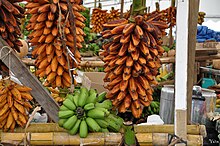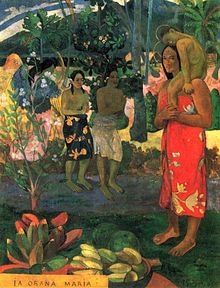Musa troglodytarum
| Musa troglodytarum | ||||||||||||
|---|---|---|---|---|---|---|---|---|---|---|---|---|

Musa troglodytarum |
||||||||||||
| Systematics | ||||||||||||
|
||||||||||||
| Scientific name | ||||||||||||
| Musa troglodytarum | ||||||||||||
| L. |

Musa troglodytarum , also called Fe'i banana , is a domesticated wild banana species from the genus of bananas ( Musa ) in the Callimusa section . It has an upright fruit stand and red-violet sap. 'Pisang Tongkat Langit' and Musa fehi also show these characteristics. 'Pisang Tongkat Langit' means"sky-pointing banana"in Indonesian .
Fe'i banana, 'Pisang Tongkat Langit' and Musa fehi can be botanically considered together as Musa troglodytarum . The species occurs on islands in the Pacific Ocean , on the Moluccas and in Papua New Guinea . The fruit is rarely eaten raw.
description
Similar to other banana trees, Fe'i can reach heights of 3–10 m. In contrast to other banana plants, it has no white, but red sap. The fruit is cylindrical, plump, the skin of the ripe fruit is red-orange-red with dark brown spots, the flesh is bright golden-yellow to orange and may contain a few flat, brown seeds.
The fruits of Musa fehi that grow in higher elevations are said to contain seeds, while those from lower elevations are seedless.
The pulp of 'Pisang Tongkat Langit' smells wild and tastes astringent. The ripe fruit tastes sweet and is easily digestible. Eating freshly harvested fruits raw can occasionally cause itching. The fruit becomes more digestible after storage. When the fruit is slowly fried in ash, it tastes better and is also sweeter. This type of banana should be better used as a cooked banana (English plantain). After consumption, the urine turns reddish-red in color, similar to that after consuming beetroot.
' Cavendish ' bananas (left) and 'Karat' bananas, a Fe'i banana variation (right)
history
'Pisang Tongkat Langit' was first described in detail in the Moluccas by the German-Dutch naturalist Georg Eberhard Rumpf , nicknamed Pliny Indicus . Rumpf called this strange type of banana Musa Uranoscopos . He realized that a type of banana with an upright fruit cluster and red sap is unusual and does not belong to varieties of dessert bananas ( Musa x paradisiaca ). In the Moluccas, this type of banana is cultivated as a rarity in gardens.
Georg Eberhard Rumpf , who was born in Wölfersheim, lived on Ambon for 45 years until his death . He sent his manuscript twice from Ambon to Holland in 1688 and 1690. With the first shipment, the ship capsized on the way from Batavia to Holland. Since Rumpf published his botanical descriptions before the introduction of the binomial nomenclature by Linnaeus in Species Plantarum in 1753, the botanical name Musa uranoscopos for 'Pisang Tongkat Langit' is not valid today .
In the dissertation of Olavus Stickman, a PhD student of Linné , on Herbarium Amboinense , the plants described by Rumpf were given the binominal nomenclature introduced by Linné . It is noteworthy that no other names have been added for Musa uranoscopos .
The botanists Daniel Solander and Joseph Banks accompanied James Cook on the first South Seas voyage 1768–1771 on the Endeavor . Solander reported on five types of bananas, which were called Fe'i in Tahiti. William Ellis, who lived in the Society Islands for almost eight years , found that Fe'i bananas were a staple food of the population in individual Polynesian islands. These are high in vitamin A and carbohydrates.
In New Caledonia , the French naturalist Eugène Vieillard (1819-1896) found a semi-domesticated type of banana with an upright fruit cluster and red-violet sap ; in 1862 he named it Musa fehi .
Botanical
The origin of this type of banana is not clearly established. It used to be assigned to the Australimusa section. Today this section is merged into the Callimusa section. It has been suggested that Musa maclayi from Papua New Guinea could be one of the ancestors of this type of banana.
The botanical name of the Fe'i banana is probably Musa troglodytarum L. ( specific epithet from Linné for a species native to Oceania from Latin Troglodytae <Greek trough (l) odytai ‹a people apparently assigned to the pygmies›; however, the designation motif is unknown.) The use of this name was controversial for centuries, partly because Linnaeus mixed two types of banana under one description (the second is now called Musa balbisiana ). Linnaeus himself did not have any material of the kind, his description is based on the careful description and illustration of Rumpf. Later editors tried to clear up the confusion created by Linnaeus, increasing it even further by introducing a large number of ( illegitimate ) substitute names, including Rumpf's old name uranoscopos . The species described as Musa fehi Bertero ex Vieillard in 1862 is also the same species, the plants described under this name have with Musa troglodytarum, among other things, the origin from culture (there are no real wild occurrences known), the upright, non-hanging inflorescence and the red color in common. There is no type material for direct comparison.
The banana depicted by Blanco in “Flora de Filipinas” 1880–1883 as Musa troglodytarum is not identical to the Fe'i bananas, 'Pisang Tongkat Langit' and Musa fehi . The peel (illustration) is greenish-yellow, the flesh is white with many pips and the sap of the pseudo-stem is white. Fe'i banana, 'Pisang Tongkat Langit' and Musa fehi do not show these characteristics.
For Musa fehi , a banana species native to the Fiji Islands, Dodds found that this species only has 10 pairs of chromosomes like other species in the Callimusa section. The number of chromosomes of the species in the Musa section is 11 pairs. The Fe'i bananas, 'Pisang Tongkat Langit' and Musa fehi were summarized as Musa troglodytarum .
In Tahiti , the Fiji Islands , Tonga , Samoa and Hawaii MacDaniels found 13 variations of Fe'i banana.
Synonyms

- Musa uranoscopos ex Rumph.
- Musa fehi Bertero ex Vieill.
- Musa × paradisiaca subsp. troglodytarum (L.) K. Schum.
- Musa × paradisiaca var. Dorsata G. Forst.
- Musa rectispica Nakai
- Musa × sapientum subsp. troglodytarum (L.) Baker
- Musa seemannii F. Muell.
- Musa troglodytarum var. Acutibracteata macdan.
- Musa uranospos Colla
- Musa uranoscopos Lour.
use
The cultivation of this type of banana in their homeland as a staple food should be encouraged to prevent vitamin A deficiency . In areas where bananas are grown for export, vitamin A deficiency is common among the low-income population. Their diet consists mainly of those bananas that cannot be exported or sold. Fe'I bananas with golden yellow flesh are rich in β-carotene, a precursor of vitamin A. There are varieties that are also tasty raw, e.g. B. 'Karat' bananas. To prevent vitamin A deficiency, the cultivation of this type of banana could be recommended.
Unfortunately, the acceptance of the Fe'i banana in the population is declining.
In Australia the Apsy2a gene was transferred from 'Asupina' to a Cavendish cultivar. This gene plays an important role in the biosynthesis of carotenes . 'Asupina' contains 20 times more carotenes than a dessert banana. This concept could play a role in the local cultivation of bananas in Uganda in order to prevent vitamin A deficiency in the population.
Fe'i bananas play a major role in ceremonial celebrations in the Marquesas and Society Islands .
Similar to the leaves of other types of bananas, the fresh leaves of Fe'i bananas are also used as food packaging material or as a tablecloth. Dried leaves are useful for roofing huts and tied bill trunks can be used as a raft for short distances. In the past, the red-purple sap was used as an ink by missionaries .
Varieties and variations

- 'Karat' cultivars in Micronesia
- 'Utin lap' cultivars in Micronesia
- 'Aibwo', 'Fagufagu', 'Gatagata' in the Solomon Islands
- 'Pisang Tongkat Langit' on the Moluccas
- 'Pisang Tongkat Langit Papua', 'Menei', 'Rimina' in Papua New Guinea
- 'Soaqa' in the Fiji Islands
- 'Asupina' in the Pacific region
- 'Dáak' in New Caledonia
- 'Borabora', 'Polapola' in Hawaii
Fe'i bananas in art
The French painter Paul Gauguin , who died on Hiva Oa in French Polynesia , depicted three Polynesians having a meal with Fe'i bananas in his work “Le repas”. Fe'i bananas can also be seen on his “La Orana Maria”, a traditional food of the local people of Tahiti.
swell
- Randy C. Ploetz, Angela K Kepler, Jeff Daniells, Scot C. Nelson: Banana and plantain - an overview with emphasis on Pacific island cultivars. In: Species Profiles for Pacific Island Agroforestry. February 2007, pp. 23-27.
- AK Kepler & FG Rust: The World of Bananas in Hawai'i: Then and Now. Pacific Fe'i: Maia He'i ( Musa troglodytarum ) 2012, p. 245.
- Jeanne Dericks-Tan: Bananas, of all things . In: Kulturbotanische Notes No. 2, 2014, pp. 68–71.
Individual evidence
- ↑ a b K. S. Dodds: Musa fehi, the indigenous banana of Fiji. In: Nature 157: 729-730, 1946
- ^ Georgius Everhardus Rumphius: Musa Uranoscopos - Pissang Toncat Langit. In: Herbarium Amboinense 1747 Book VIII, Cap. IV, page 137 and panel LXI scan at botanicus.org
- ↑ O. Stickman: Herbarium Amboinense, quod consens, ... Dn Doct. Caroli Linnaei. Upsaliae 1754, p. 20, https://www.biodiversitylibrary.org/item/150432#page/81/mode/1up
- ↑ DC Solander: Primitiae flore insularum Oceani Pacifici, sivi catalogus Plantarum in Otaheite, Eimeo . In: Botanical manuscript in British Museum (Nat.Hist.) Pp. 344, 1769
- ^ William Ellis: Polynesian researches during a residence of nearly eight years in the Society and Sandwich Islands. HG Bohn, London 1859
- ^ E. Vieillard: Plantes utiles de la Nouvelle-Calédonie. In: Annales des Sciences Naturelles 16: 28-76, 1862
- ↑ http://www.promusa.org/Fei+bananas Anne Vézina. ProMusa, updated March 23, 2017
- ↑ Helmut Genaust: Etymological dictionary of botanical plant names. 3rd, completely revised and expanded edition. Nikol, Hamburg 2005, ISBN 3-937872-16-7 , p. 660 (reprint from 1996).
- ↑ Markku Häkkinen, Henry Väre, Maarten Christenhusz (2012): Identity of a Pisang - historical concepts of Musa (Musaceae) and the reinstatement of Musa troglodytarum. Folia malaysiana l3 (2): l-14.
- ↑ EE Cheesman: Classification of the Bananas. III. Critical Notes on Species. Kew Bulletin No. 4: 272, 1949
- ^ LH MacDaniels 1947: A study of the fe'i banana and ist distribution with reference to Polynesian migrations. Bulletin 190. Bernice P. Bishop Museum, Honolulu, Hawai 56p.
- ↑ WHO. Global prevalence of Vitamin A deficiency- MDIS Working Paper No. 2. Micronutrient Deficiency Information System, WHO / NUT / 95.3. Geneva: World Health Organization, 1955
- ↑ Lois Englberger. Ian Darnton-Hill, Terry Coyne, Maureen H. Fitzgerald, Geoffrey C. Marks: Carotenoid-rich bananas: A potential food source for alleviating vitamin A deficieny. In: Food and Nutrition Bulletin 2003 Vol 24, No. 4th
- ^ Super bananas - world first human trial, Queensland University of Technology





